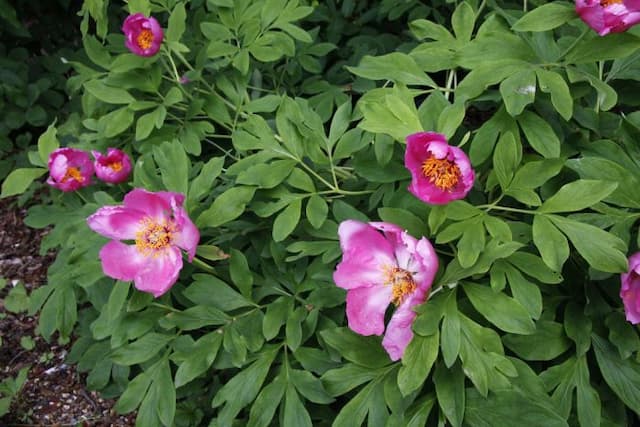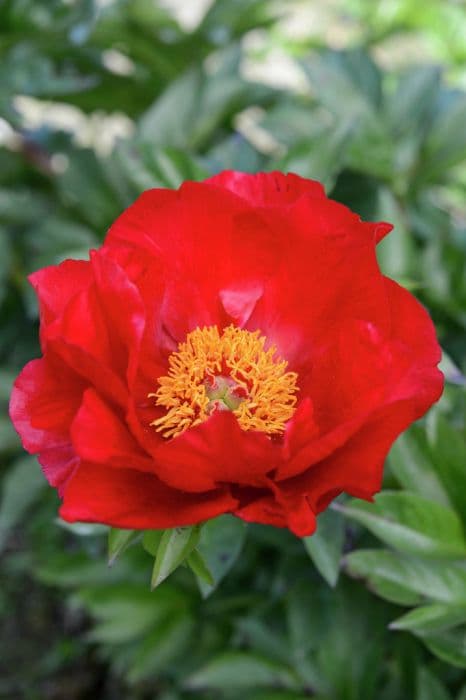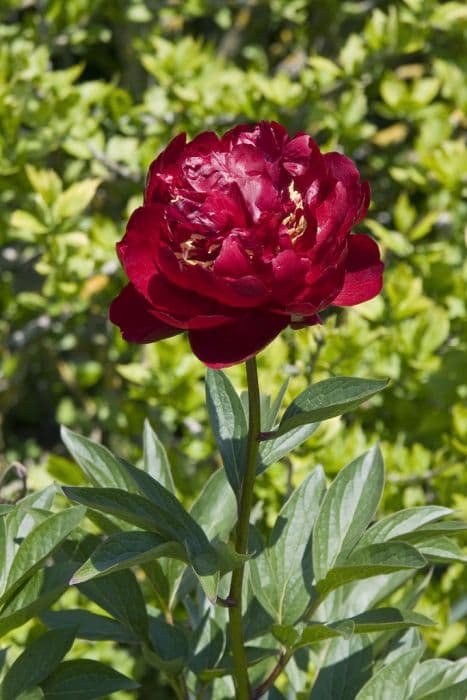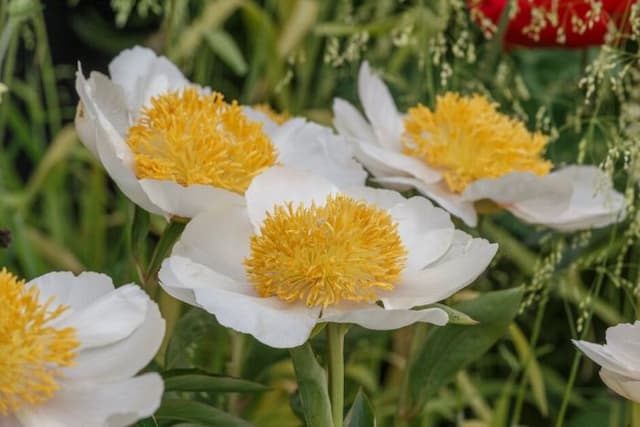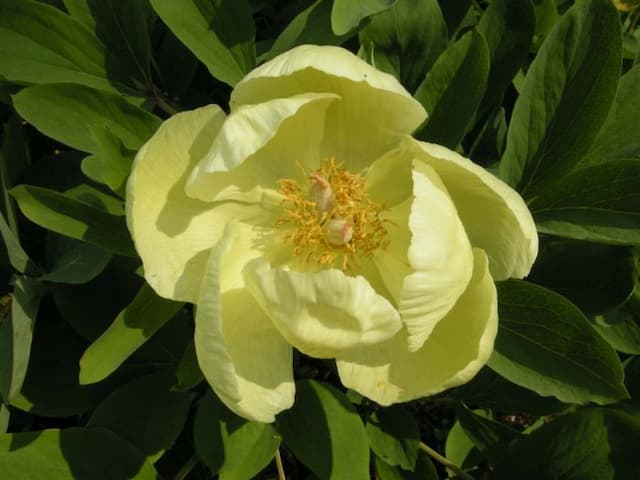Chinese Peony Paeonia lactiflora 'Barrington Belle'

ABOUT
The 'Barrington Belle' is a variety of the common peony known for its striking appearance. It boasts large, double flowers that have a deep pink coloration, making them a vibrant addition to any garden. The blooms are characterized by their numerous layered petals, which create a full and lush look and can create a stunning display when the plant is in full bloom. The petals may have a softly fading effect towards their edges, giving the flowers a subtle, two-tone impression that can vary with light conditions. These luxurious flowers often carry a pleasant fragrance, which can attract pollinators and add a sensory dimension to their ornamental value. The leaves of 'Barrington Belle' are a rich green, providing a lush backdrop for the vivid flowers. The foliage is typically dense, with each leaf being compound in shape. The glossy leaves come together to create an attractive bushy habit, which is well-formed and serves as excellent ground cover when not in bloom. As the plant matures throughout the season, the foliage can maintain its vibrancy, providing a lasting green presence in the garden. Overall, the 'Barrington Belle' peony is prized for its showy flowers and rich green foliage, which contribute to its popularity. Its appearance is a spectacle of color and beauty, particularly when in flower, charming gardeners and passersby alike.
About this plant
 Names
NamesSynonyms
White Peony, Chinese Peony, Common Garden Peony.
Common names
Paeonia lactiflora 'Barrington Belle'.
 Toxicity
ToxicityTo humans
Peony, including the variety Paeonia lactiflora 'Barrington Belle', is considered to have a low level of toxicity to humans. Ingesting parts of the plant can lead to mild gastrointestinal discomfort, such as nausea, vomiting, or diarrhea. Handling the plant might cause skin irritation in some people due to its sensitivity-inducing properties.
To pets
Peony, specifically the Paeonia lactiflora 'Barrington Belle', is known to be toxic to pets, including dogs and cats. If ingested, the peony can cause gastrointestinal upset in pets, such as vomiting or diarrhea. It is important to prevent pets from chewing on or ingesting any part of the plant to avoid these symptoms of poisoning.
 Characteristics
CharacteristicsLife cycle
Perennials
Foliage type
Deciduous
Color of leaves
Green
Flower color
Pink
Height
2-3 feet (60-90 cm)
Spread
2-3 feet (60-90 cm)
Plant type
Herb
Hardiness zones
3-8
Native area
Asia
Benefits
 General Benefits
General Benefits- Ornamental Value: Paeonia lactiflora 'Barrington Belle', commonly known as peony, adds beauty to gardens with its large, double flowers with deep pink petals.
- Attracts Pollinators: The blooms entice a variety of pollinators, including bees, butterflies, and birds, which can help pollinate other plants in the garden.
- Longevity: Peonies are known for their long lifespan, sometimes living for decades, providing long-term value for gardeners.
- Seasonal Interest: They bloom in late spring to early summer, offering a seasonal display of color during this period.
- Fragrance: The flowers typically have a pleasant fragrance that can add a sensory experience to garden spaces.
- Cut Flowers: Peonies are popular for use in floral arrangements; their blooms have a vase life of about a week, making them a favorite for bouquets and centerpieces.
- Low Maintenance: Once established, peonies require minimal care besides occasional watering and deadheading, making them an excellent choice for low-maintenance gardening.
- Diversity in Landscaping: This peony variety provides textural contrast and can be used in borders, beds, and as focal points in landscape design.
- Cold Hardiness: Peonies are cold hardy plants, often able to withstand harsh winters in cooler climates without significant damage.
- Drought Tolerance: Once established, they can tolerate periods of drought, which is beneficial in areas with water restrictions or low rainfall.
 Medical Properties
Medical Properties- Anti-inflammatory: Paeonia lactiflora has been used in traditional medicine for its potential to reduce inflammation.
- Analgesic: It may possess pain-relieving properties.
- Immunomodulatory: There is evidence to suggest that compounds in Paeonia lactiflora can modulate the immune system.
- Antioxidant: The plant is thought to contain antioxidants that can help protect the body from oxidative stress.
 Air-purifying Qualities
Air-purifying QualitiesThis plant is not specifically known for air purifying qualities.
 Other Uses
Other Uses- Floral Arrangements: The full, lush blooms of the peony 'Barrington Belle' are often used in floral arrangements to provide a classic and elegant look, ideal for weddings or high-end events.
- Dye Production: The petals of the peony can be boiled to create a natural dye for fabrics, imparting delicate colors to textiles.
- Garden Ant Deterrent: The peony buds can be placed around other vulnerable plants to leverage a common belief that ants gathering on peony buds may help deter them from infesting nearby plants.
- Culinary Garnish: Peony petals can be used to garnish desserts and salads, providing an upscale and edible decoration that's especially popular in gourmet cuisine.
- Photography Subject: 'Barrington Belle', with its distinct large double flowers, is a favorite among photographers looking to capture the beauty of nature in gardens and floral photography.
- Essential Oil: Though not medically, the fragrance of peonies can be used to produce essential oils for use in perfumery and aromatherapy for their unique, pleasant scent.
- Crafting Potpourri: Dry petals of the peony can be added to potpourri mixes to not only add a pleasant fragrance but also an attractive visual element with their varied colors.
- Event Decoration: Live plants or cut blooms can be used as natural decor items during events, offering an eco-friendly and biodegradable option for centerpieces and venue decoration.
- Artistic Inspiration: The peony has been a long-standing muse for painters and artists, inspiring art pieces ranging from traditional oil paintings to modern digital artwork.
- Teaching Tool: The distinct morphology of the peony can be used by educators teaching botany or horticulture as an example of plant structure, pollination, and propagation techniques.
Interesting Facts
 Feng Shui
Feng ShuiPeony is often used in Feng Shui for its strong symbolism of wealth, prosperity, and honor. It's commonly placed in the southwest area of a garden or home to enhance love and romance. The lush blossoms are also associated with feminine beauty and can be utilized in the bedroom to attract positive relationship energy.
 Zodiac Sign Compitability
Zodiac Sign CompitabilityThe peony is not used in astrology practice.
 Plant Symbolism
Plant Symbolism- Beauty: Paeonia lactiflora, commonly known as the Chinese Peony, is often associated with beauty due to its large, full, and vibrant blooms that are considered to epitomize floral beauty.
- Wealth and honor: In Chinese culture, peonies are considered a symbol of wealth and honor. They are frequently found in royal gardens and have been coveted by the affluent and elite.
- Romance and love: The lush and rounded peony blossoms symbolize romantic love, often used in weddings and given as tokens of affection.
- Good fortune and prosperity: The Chinese Peony is believed to bring good luck and prosperity to those who grow them or receive them, making them a popular plant for new ventures and homes.
- Compassion: Its plush petals can represent the nurturing and compassionate nature of a person, signifying kindness and empathy.
- Bravery: In some cultures, the peony stands for bravery, as their bold presence in a garden can be reflective of a courageous spirit.
 Water
WaterPeonies like 'Barrington Belle' require thorough watering to establish deep roots, especially during their first few years. These plants should be watered deeply once a week, supplying about one gallon of water per plant, particularly in the absence of rain. During the growing season, as the weather gets hotter, make sure the soil remains moist but not soggy. In the event of a particularly dry spell, increase watering to twice a week. Once established, peonies are somewhat drought-tolerant but will appreciate consistent moisture for optimal growth and bloom.
 Light
LightPeonies, including the 'Barrington Belle' variety, thrive in full sun to partial shade. They need at least six hours of sunlight daily to flourish and produce vibrant blooms. A spot that receives morning sun and some afternoon shade is best to protect the flowers from the intense late-day sun, which can sometimes cause fading or wilting.
 Temperature
TemperatureThe 'Barrington Belle' peony prefers a temperate climate with temperatures ranging from around 40°F to 85°F. They need cold winters, with temperatures dropping to at least 0°F, to undergo the dormancy required for proper spring blooming. Superb blooming occurs when they experience a period of winter chill followed by the warmth of spring.
 Pruning
Pruning'Barrington Belle' peonies should be pruned to remove spent blooms after flowering to maintain a neat appearance and prevent seed formation that can reduce next year's blooms. Pruning in late fall, after the foliage has died back, helps prevent disease by removing any potential overwintering fungus. Cutting the stems down to about 3 inches above the ground annually is generally recommended.
 Cleaning
CleaningAs needed
 Soil
SoilPeony 'Barrington Belle' thrives in well-draining, fertile soil with a pH of 6.5 to 7.5. A mix of loamy garden soil, compost, and perlite or coarse sand is ideal to ensure proper drainage and fertility. Amend with organic matter to enhance the soil structure and nutrient content.
 Repotting
RepottingPeonies, including 'Barrington Belle', generally do not require frequent repotting and can thrive in the same location for many years. They should only be divided or repotted if they become overcrowded, typically every 10 to 15 years.
 Humidity & Misting
Humidity & Misting'Barrington Belle' Peony prefers average to high humidity levels but is adaptable to most climate conditions found within its growing zone as long as it's not excessively dry. No specific humidity level is needed.
 Suitable locations
Suitable locationsIndoor
Peony 'Barrington Belle' often struggles indoors; it needs cold dormancy.
Outdoor
For 'Barrington Belle' Peony, plant in full sun and well-drained soil.
Hardiness zone
3-8 USDA
 Life cycle
Life cyclePaeonia lactiflora 'Barrington Belle', commonly known as Chinese peony or Barrington Belle peony, begins its life cycle with germination of seeds or growth of new shoots from tuberous roots in early spring. The plant then develops compound, deeply lobed leaves and sturdy stems that prepare it for the flowering stage. By late spring to early summer, the plant produces large, fragrant flowers, typically in shades of pink or red, which attract pollinators such as bees. After pollination, the flowers give way to seed pods if fertilization has occurred. In late summer, the peony plant begins to store energy in its roots as leaves yellow and die back, entering dormancy in preparation for winter. With the arrival of the next spring, the cycle repeats as the plant emerges from dormancy and begins to grow anew.
 Propogation
PropogationPropogation time
Late winter to early spring
The Paeonia lactiflora 'Barrington Belle', commonly known as the Peony, is most commonly propagated through division, which is a suitable method for many herbaceous perennials. This is best done in the fall after the plant has gone dormant, usually after the first frost when the soil can still be worked. Division involves digging up an established peony plant and carefully separating the root ball into smaller sections, making sure each new section has at least three to five eyes, which are the potential growth points for new stems. The divisions should then be planted at the same soil depth as the original plant, spacing them about 2 to 3 feet apart (60 to 90 centimeters) to allow for adequate growth. It's crucial to water the new divisions thoroughly and keep the soil moist to help establish the plants.
